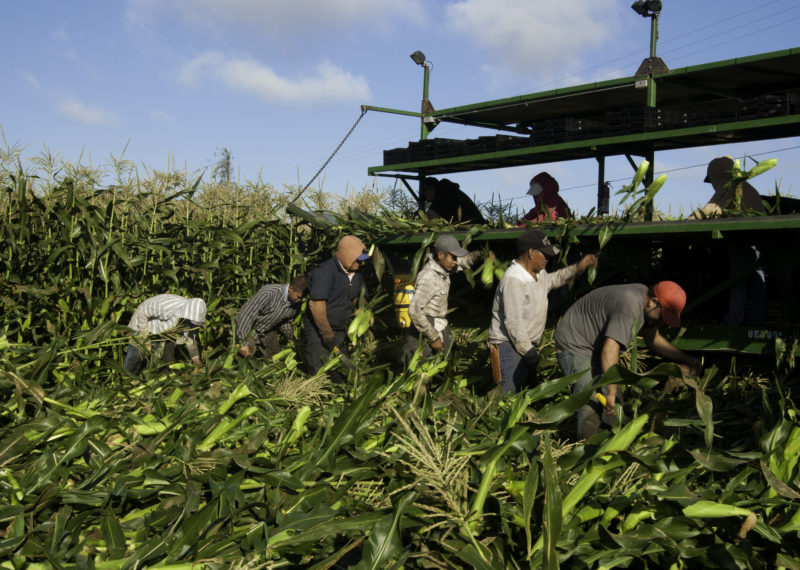In August 2017, as wildfires raged across British Columbia, a blanket of smoke settled over the neighboring state of Washington, turning the sun blood-red and filling the air with grit and ash. At Sarbanand Farms, a blueberry orchard in Sumas, Washington, a 28-year-old seasonal worker named Honesto Silva Ibarra collapsed and later died. His fellow workers attributed his cardiac arrest to long hours working in the smoky heat.
Silva’s death triggered a series of strikes across the state, including a 70-worker walkout at Sarbanand Farms, to demand safer working conditions.
“We knew something had to be done around wildfires and heat and smoke,” said Edgar Franks, who worked in the fields for years before eventually becoming political director of the Washington-based union Familias Unidas por la Justicia. “Every year after that, it’s just getting hotter and hotter and more unpredictable.”
The climate crisis has made farm work more dangerous and precarious. In the U.S., at least 384 farm workers died of heat-related causes between 2010 and 2020, according to a 2021 investigation by NPR and the Columbia Journalism School. The number of days in which extreme heat poses a risk to field laborers’ physical safety is expected to nearly double by 2050.
Extreme heat, wildfires, and floods also endanger farmworkers’ livelihoods. In California, an unusually wet and cold winter has left fields soaking and frost-ridden, leaving workers with little option but to wait for conditions to improve without pay and farmers with less income to pay them. A 2021 analysis by the Union of Concerned Scientists estimated that outdoor workers in the U.S. risk losing a collective $55.4 billion in earnings each year to climate-related extreme heat.
But advocates say the 2023 Farm Bill, legislation that determines how the U.S. Department of Agriculture (USDA) distributes billions of dollars over the next five years, is an opportunity to bring life and livelihood-saving protections to these workers.
The USDA does not have the jurisdiction to create or enforce traditional labor protections, which fall under the purview of the Department of Labor and the Occupational Safety and Health Administration. But what it can do, advocates say, is create conditions that might make it easier for workers to turn down dangerous jobs.
“Regulators, legislators, and companies have spent so many decades with this traditional belief that the Farm Bill isn’t about workers,” said Ademola Oyefeso, International Vice President of the United Commercial and Food Workers Union, one of a handful of organizations advocating for a “labor-focused” Farm Bill. “We have to break through that noise and explain that you can do everything you can to stimulate the farm industry, but if you don’t take care of the workforce, you won’t get anything from it.”
Oyefeso said the upcoming Farm Bill could incentivize employers to take care of their workers by only providing business or funding opportunities to those with strong records of worker safety. “What you have in the Farm Bill is the opportunity to regulate who gets money,” he said. “You don’t want a company with a lot of labor violations, where workers are getting hurt constantly, to get these contracts that are coming up.”
Franks, the union political director, said that the USDA could set aside money that farmworkers could access when extreme heat, wildfire, intense flooding, or a surprise frost prevents them from working. “We would think that if there’s potential danger to your health, work should stop, and funding should be available if workers need to stop,” he said. California’s Sonoma County, for example, is currently piloting a program that offers a one-time payment to farmworkers for lost wages due to unprecedented spring floods.
Emma Scott, a clinical instructor at Harvard University’s Food Law and Policy Clinic, said that the pandemic revealed both how vulnerable farmworkers and other essential workers were to illness and economic shocks, but also how quickly and effectively emergency funds could be distributed to protect them. Scott works on the Farm Bill Law Enterprise Project, a coalition across several top law schools that wrote proposals for the 2023 Farm Bill. Those proposals include disbursements to protect farmers’ livelihoods in periods of climate disaster and USDA funding for research into climate- and stress-related health risks.
In 2021, the USDA launched the Farm and Food Workers Relief Grant Program, providing nearly $670 million to state agencies, tribes, and nonprofits that support or provide relief to farm or meatpacking workers. Scott said that the Farm Bill could fund a more comprehensive and faster-acting version of that program.
“In the same way that the USDA provides emergency assistance to farmers, it can actually step in and act swiftly to provide emergency grants to organizations serving farmworkers to help when disaster strikes that disrupt agriculture,” she said.
Advocates are also seeking funding for research into a variety of health issues that affect farmworkers. Those include the results of exposure to toxic pesticides, both acute and long-term impacts of heat stress, or anxiety and depression from the volatile nature of farm work. “By incorporating farmworker needs and priorities into these requests for applications, we could see more opportunities for folks who are doing community-based research for farmworkers around these health and safety issues,” said Scott.
A labor-focused Farm Bill could also enable workers to obtain land and start their own farms, said Amy Tamayo, national policy and advocacy coordinator for the California-based Alianza Nacional de Campesinas (National Alliance of Women Farmworkers). That, in turn, could facilitate the adoption of more climate- and worker-friendly farming practices.
“Addressing some of these inequities means increasing the opportunity for more sustainable, pesticide-free producers to be in the market,” she said. “A different type of farming practice [could] produce food that is healthy for our bodies and the land.”
The 2008 Farm Bill created a farmworker coordinator position at the USDA; expanding that position into an office would make the agency — and its opportunities for farmers — more accessible to farmworkers, she added.
Franks also noted that the climate benefits of a worker-oriented Farm Bill could extend beyond the field. Some Washington-based farmworker groups are seeking training from the state in forest cleanup and controlled burning, practices that help mitigate the risk of more intense and widespread wildfires.
“There’s an opportunity within the Farm Bill to really start funding these kinds of programs and listening to people who have been on the frontlines and the ones that hardly get listened to,” Franks said. “It’s a chance to get creative.”
This article is copublished with Ambrook Research as part of a series that looks at ways the 2023 Farm Bill can help address the climate crisis. Nexus Media News is an editorially independent, nonprofit news service covering climate change. Follow us @NexusMediaNews.


